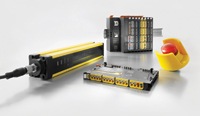
Posted to News on 23rd Jan 2017, 00:00
Safety options for modern control systems
With the exception of the simplest, modern control systems are invariably built around some sort of programmable device – typically a smart relay or a PLC. But what’s the best way to implement safety functions for these systems? Peter Croucher of Weidmuller UK investigates.

Not so very long ago, safety functions for control systems typically looked rather like bolt-on extras. They were implemented with separate safety relays that worked in conjunction with – rather than as part of – the control system. Whilst this approach is still widely used, by today’s standards it’s costly and inflexible, as well as being poorly suited to distributed control systems. And those safety relays take up a lot of valuable space in control panels.
Fortunately, much more attractive safety options are now available, particularly for the growing number of applications where distributed I/O – often known as “slice I/O” – is used. These new safety options are implemented as modules that fit within the distributed I/O assembly, which means that they take up a remarkably small amount of space. In fact, some of the latest modules are just 11.5mm wide and are easy to accommodate even in the most cramped of control cabinets.
To enable cost-effective solutions to be implemented for the widest possible range of safety applications, these innovative modules are offered in two basic types – those designed to work without a safety PLC, and those designed to work in conjunction with a safety PLC and safety fieldbus system.
Modules of the first type are often described as safe power-feed modules and, in principle, they function by monitoring safety inputs and, when these are activated, removing power from selected circuits in the distributed I/O system. While the basic operation of these modules is easy to understand, the sophistication of their design and implementation should not be underestimated.
To give users an idea of what they can expect from a module of this type, it’s instructive to examine the characteristics of one of the latest types, the safe power-feed module in the Weidmüller u-remote range.
This has a safety level of SIL 3 CL in line with DIN EN IEC 62061 and Category 4, PL e, in line with DIN EN ISO 13849-1, allowing it to be used in even the most demanding applications. Two independent safety circuits can be implemented with a single power-feed module, and these circuits need not necessarily be of the same type. One, for example, could be a chain of emergency stop buttons with conventional contacts, while the other could be a light curtain or a laser scanner with a solid-state OSSD output.
A current rating of 8 A means that each module can safely shut down multiple circuits, and the functionality of the modules can be further extended by cascading them. This means that the switching output of one module serves as the input of the next module, allowing linked protection zones to be created in a single application.
Clearly, these safe power-feed modules are very versatile and, since they are designed for use without a safety PLC and can control standard output modules, they can be used to implement efficient and very cost-effective safety systems for a wide range of applications. They do, however, have their limitations, especially where the response to an emergency condition needs to be more sophisticated than simply cutting the power to a group of circuits.
For these more complex applications, the second type of safety module for distributed I/O systems is a more appropriate choice. Modules of this type are designed for use in conjunction with a safety PLC and a safety fieldbus system. They can be implemented in a wide range of safety applications, and they are particularly well suited for use with modern decentralised control architectures. The best types feature high I/O density that allows very compact safety I/O solutions to be implemented.
The modules must, of course, be chosen to match the type of safety fieldbus in use, but types are readily available for the two most popular options: Fail Safe over EtherCAT (FSoE) for EtherCAT networks, and PROFIsafe for use with the PROFIBUS and PROFINET fieldbus systems.
Whether the safe power-feed or networked options are chosen, there is another very important benefit associated with using these new modules: easy access to status information. With the latest systems, the status of the safety modules can be interrogated along with the status of the standard inputs and outputs in the system. Even better, this can be done without using any special software – all that’s needed is an ordinary web browser.
Implementing safety functions as part of a distributed I/O system brings many benefits. The solutions are compact, flexible, easily integrated into the design of modern control systems, and their operation can be conveniently monitored. The availability of two principal options – safe power-feed and networked modules – means that efficient, dependable and cost-effective solutions can be developed for almost any application, from the simplest to the most complex. So it is worth partnering with a true specialist that will deliver the latest technology and solutions for safety systems that are reliable and future proof.
Klippon House, Centurion Court Office Park
Meridian East, Meridian Business Park
LE19 1TP
UNITED KINGDOM
+44(0)116 282 3470






